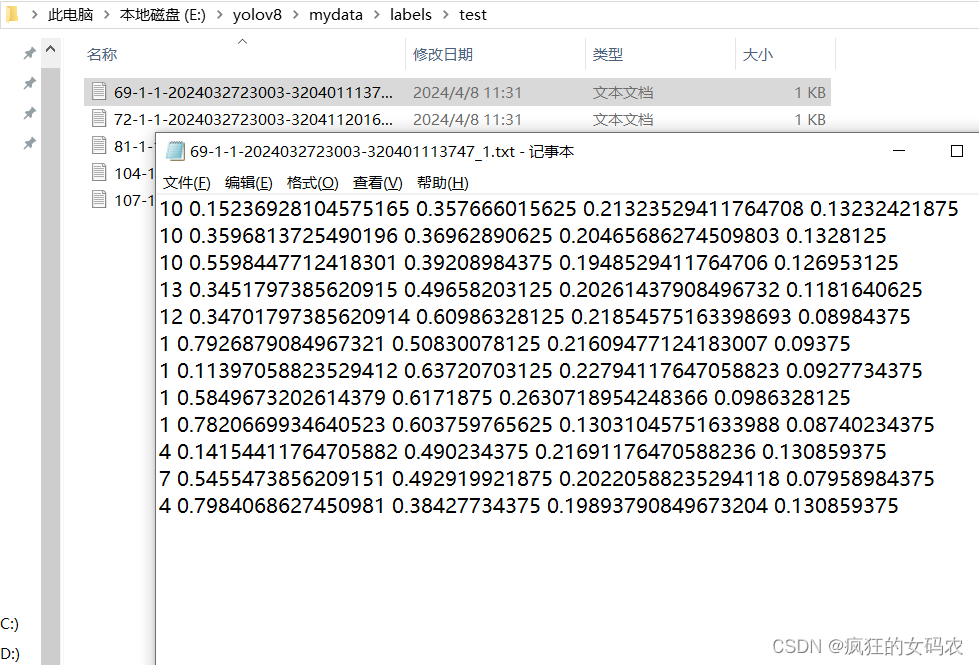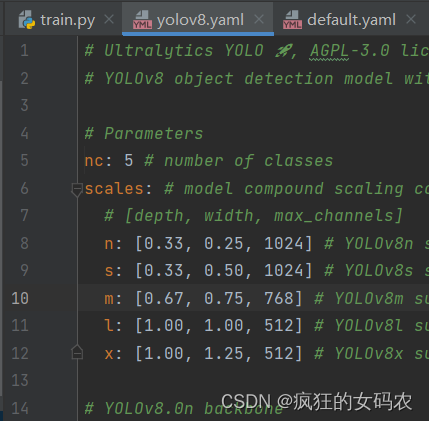前情提要:第一次玩yolov8,记录下踩坑过程,本篇指南主要参考YOLOv8训练自己的数据集,同时记录了自己在这个过程中遇到的其他问题以及解决的办法。
代码下载地址:ultralytics/ultralytics: NEW - YOLOv8 🚀 in PyTorch > ONNX > OpenVINO > CoreML > TFLite (github.com)
解压后重命名文件夹,我把文件夹‘ultralytics-main'改成了'yolov8'的名字。
目录
一、搭建conda环境
1、创建新环境
按下'win'+'r',输入cmd,然后输入以下命令:
conda create -n yolov8 python=3.8
2、激活环境:conda activate yolov8
3、切换当前路径到文件夹下:cd yolov8
4、安装环境包:pip install ultralytics -i https://pypi.tuna.tsinghua.edu.cn/simple
(这个我看有的帖子还让安装requirements.txt,但本人没在下载的文件夹里找到,调研了原因是因为相关配置要求都集成到ultralytics里啦,所以只用安装ultralytics)
二、数据集准备
2.1 数据标注
1、准备好自己的图片数据
2、在当前环境中安装labelimg(图片标注工具)
pip install labelimg -i https://pypi.tuna.tsinghua.edu.cn/simple
我安装的是1.8.6版本
3、在cmd中打开labelimg
![]()
4、在labelimg界面中标注图片,我保存成了VOC格式,即标注文件以.xml为后缀
2.2 数据集划分
5、将数据集随机划分为 train\test\val 三个类别
在项目文件夹yolov8目录下新建一个文件夹mydata。 在mydata文件夹下分别建立dataset、images、labels、xml四个文件夹,其中将图像数据都放到images中,将标注好的xml文件放到xml文件夹中。

然后在mydata文件夹下新建一个名为split_train_val.py的文件,用于实现训练集/测试集/验证集的划分,具体代码如下:
# coding:utf-8
import os
import random
import argparse
parser = argparse.ArgumentParser()
# xml文件的地址,根据自己的数据进行修改 xml一般存放在Annotations下
parser.add_argument('--xml_path', default='xml', type=str, help='input xml label path')
# 数据集的划分,地址选择自己数据下的ImageSets/Main
parser.add_argument('--txt_path', default='dataset', type=str, help='output txt label path')
opt = parser.parse_args()
trainval_percent = 0.9
train_percent = 0.7
xmlfilepath = opt.xml_path
txtsavepath = opt.txt_path
total_xml = os.listdir(xmlfilepath)
if not os.path.exists(txtsavepath):
os.makedirs(txtsavepath)
num = len(total_xml)
list_index = range(num)
tv = int(num * trainval_percent)
tr = int(tv * train_percent)
trainval = random.sample(list_index, tv)
train = random.sample(trainval, tr)
file_trainval = open(txtsavepath + '/trainval.txt', 'w')
file_test = open(txtsavepath + '/test.txt', 'w')
file_train = open(txtsavepath + '/train.txt', 'w')
file_val = open(txtsavepath + '/val.txt', 'w')
for i in list_index:
name = total_xml[i][:-4] + '\n'
if i in trainval:
file_trainval.write(name)
if i in train:
file_train.write(name)
else:
file_val.write(name)
else:
file_test.write(name)
file_trainval.close()
file_train.close()
file_val.close()
file_test.close()
运行以上程序后,就将图片名划分到了不同的数据集中。

2.3 数据集格式转换
6、将VOC格式的数据集转为YOLO格式
① 在labels文件夹下新建如下文件夹:

② 在mydata文件夹下新建一个名为voc_label.py的文件并运行,具体内容如下:
# -*- coding: utf-8 -*-
import xml.etree.ElementTree as ET
import os
from os import getcwd
sets = ['train', 'val', 'test']
classes = ["dog", "cat", "rabbit", "people", "car"] # 改成自己的类别
abs_path = os.getcwd()
print(abs_path)
def convert(size, box):
dw = 1. / (size[0])
dh = 1. / (size[1])
x = (box[0] + box[1]) / 2.0 - 1
y = (box[2] + box[3]) / 2.0 - 1
w = box[1] - box[0]
h = box[3] - box[2]
x = x * dw
w = w * dw
y = y * dh
h = h * dh
return x, y, w, h
def convert_annotation(image_id, image_set):
in_file = open('./xml/%s.xml' % (image_id), encoding='UTF-8')
out_file = open('./labels/%s/%s.txt' % (image_set, image_id), 'w')
tree = ET.parse(in_file)
root = tree.getroot()
size = root.find('size')
w = int(size.find('width').text)
h = int(size.find('height').text)
for obj in root.iter('object'):
difficult = obj.find('difficult').text
cls = obj.find('name').text
if cls not in classes or int(difficult) == 1:
continue
cls_id = classes.index(cls)
xmlbox = obj.find('bndbox')
b = (float(xmlbox.find('xmin').text), float(xmlbox.find('xmax').text), float(xmlbox.find('ymin').text),
float(xmlbox.find('ymax').text))
b1, b2, b3, b4 = b
# 标注越界修正
if b2 > w:
b2 = w
if b4 > h:
b4 = h
b = (b1, b2, b3, b4)
bb = convert((w, h), b)
out_file.write(str(cls_id) + " " + " ".join([str(a) for a in bb]) + '\n')
wd = getcwd()
for image_set in sets:
if not os.path.exists('./labels/' + image_set + '/'):
os.makedirs('./labels/' + image_set + '/')
image_ids = open('./dataset/%s.txt' % (image_set)).read().strip().split()
list_file = open('./labels/%s.txt' % (image_set), 'w')
for image_id in image_ids:
list_file.write(abs_path + '\images\%s.jpg\n' % (image_id))
convert_annotation(image_id, image_set)
list_file.close()
按照以上步骤,我们就成功将VOC格式的数据转为了YOLO格式,并将新的数据保存在了yolov8/mydata/labels下的train、test、val中,如下图所示,每一行代表一个标定框,第一位数字表示标签序号,后边四位数字表示标定框的长宽及位置信息。

同理,在images文件夹下也新建train、test、val文件夹,并将对应的图片也划分到对应的数据集文件夹种。

2.4 数据集制作
在mydata文件夹下,此时已经有了images、labels两个文件夹,我这里还有test_images文件夹,里面放了几张图片是用来做测试的,当然test_images这个文件夹也可以没有。

然后新建一个data_nc5.yaml文件,文件名可以自己命名,后缀需是yaml。文件内容如下:
# path
train: E:/yolov8/mydata/images/train
val: E:/yolov8/mydata/images/val
# number of classes
nc: 5
# class names
names: ["dog", "cat", "rabbit", "people", "car"]
至此,数据集就制作好了。
三、训练
3.1 新建train.py文件
在yolov8路径下新建一个train.py文件,内容如下:
from ultralytics import YOLO
model = YOLO('yolov8n.yaml')
results = model.train(data='./mydata/data_nc5.yaml', batch=8, epochs=300)3.2 修改参数文件
首先,在yolov8\ultralytics\cfg\models\v8\下有yolov8.yaml这个文件,将该文件中的nc: 80改成我们数据集中标签的类别数量nc: 5。

在yolov8\ultralytics\cfg\下有个default.yaml文件,按需求修改相关参数。对于这些参数的解释,可以参考:YOLOv8参数详解

我是在windows的gpu上运行的,已经不记得改了哪些参数,就把参数都贴出来吧:
# Ultralytics YOLO 🚀, AGPL-3.0 license
# Default training settings and hyperparameters for medium-augmentation COCO training
task: detect # (str) YOLO task, i.e. detect, segment, classify, pose
mode: train # (str) YOLO mode, i.e. train, val, predict, export, track, benchmark
# Train settings -------------------------------------------------------------------------------------------------------
model: # (str, optional) path to model file, i.e. yolov8n.pt, yolov8n.yaml
data: # (str, optional) path to data file, i.e. coco128.yaml
epochs: 100 # (int) number of epochs to train for
time: # (float, optional) number of hours to train for, overrides epochs if supplied
patience: 100 # (int) epochs to wait for no observable improvement for early stopping of training
batch: 8 # (int) number of images per batch (-1 for AutoBatch)
imgsz: 640 # (int | list) input images size as int for train and val modes, or list[w,h] for predict and export modes
save: True # (bool) save train checkpoints and predict results
save_period: -1 # (int) Save checkpoint every x epochs (disabled if < 1)
cache: False # (bool) True/ram, disk or False. Use cache for data loading
device: 0 # (int | str | list, optional) device to run on, i.e. cuda device=0 or device=0,1,2,3 or device=cpu
workers: 0 # (int) number of worker threads for data loading (per RANK if DDP)
project: # (str, optional) project name
name: # (str, optional) experiment name, results saved to 'project/name' directory
exist_ok: False # (bool) whether to overwrite existing experiment
pretrained: False # (bool | str) whether to use a pretrained model (bool) or a model to load weights from (str)
optimizer: auto # (str) optimizer to use, choices=[SGD, Adam, Adamax, AdamW, NAdam, RAdam, RMSProp, auto]
verbose: True # (bool) whether to print verbose output
seed: 0 # (int) random seed for reproducibility
deterministic: True # (bool) whether to enable deterministic mode
single_cls: False # (bool) train multi-class data as single-class
rect: False # (bool) rectangular training if mode='train' or rectangular validation if mode='val'
cos_lr: False # (bool) use cosine learning rate scheduler
close_mosaic: 10 # (int) disable mosaic augmentation for final epochs (0 to disable)
resume: False # (bool) resume training from last checkpoint
amp: False # (bool) Automatic Mixed Precision (AMP) training, choices=[True, False], True runs AMP check
fraction: 1.0 # (float) dataset fraction to train on (default is 1.0, all images in train set)
profile: False # (bool) profile ONNX and TensorRT speeds during training for loggers
freeze: None # (int | list, optional) freeze first n layers, or freeze list of layer indices during training
multi_scale: False # (bool) Whether to use multiscale during training
# Segmentation
overlap_mask: True # (bool) masks should overlap during training (segment train only)
mask_ratio: 4 # (int) mask downsample ratio (segment train only)
# Classification
dropout: 0.0 # (float) use dropout regularization (classify train only)
# Val/Test settings ----------------------------------------------------------------------------------------------------
val: True # (bool) validate/test during training
split: val # (str) dataset split to use for validation, i.e. 'val', 'test' or 'train'
save_json: False # (bool) save results to JSON file
save_hybrid: False # (bool) save hybrid version of labels (labels + additional predictions)
conf: # (float, optional) object confidence threshold for detection (default 0.25 predict, 0.001 val)
iou: 0.7 # (float) intersection over union (IoU) threshold for NMS
max_det: 300 # (int) maximum number of detections per image
half: False # (bool) use half precision (FP16)
dnn: False # (bool) use OpenCV DNN for ONNX inference
plots: True # (bool) save plots and images during train/val
# Predict settings -----------------------------------------------------------------------------------------------------
source: # (str, optional) source directory for images or videos
vid_stride: 1 # (int) video frame-rate stride
stream_buffer: False # (bool) buffer all streaming frames (True) or return the most recent frame (False)
visualize: False # (bool) visualize model features
augment: False # (bool) apply image augmentation to prediction sources
agnostic_nms: False # (bool) class-agnostic NMS
classes: # (int | list[int], optional) filter results by class, i.e. classes=0, or classes=[0,2,3]
retina_masks: False # (bool) use high-resolution segmentation masks
embed: # (list[int], optional) return feature vectors/embeddings from given layers
# Visualize settings ---------------------------------------------------------------------------------------------------
show: False # (bool) show predicted images and videos if environment allows
save_frames: False # (bool) save predicted individual video frames
save_txt: False # (bool) save results as .txt file
save_conf: False # (bool) save results with confidence scores
save_crop: False # (bool) save cropped images with results
show_labels: True # (bool) show prediction labels, i.e. 'person'
show_conf: True # (bool) show prediction confidence, i.e. '0.99'
show_boxes: True # (bool) show prediction boxes
line_width: # (int, optional) line width of the bounding boxes. Scaled to image size if None.
# Export settings ------------------------------------------------------------------------------------------------------
format: torchscript # (str) format to export to, choices at https://docs.ultralytics.com/modes/export/#export-formats
keras: False # (bool) use Kera=s
optimize: False # (bool) TorchScript: optimize for mobile
int8: False # (bool) CoreML/TF INT8 quantization
dynamic: False # (bool) ONNX/TF/TensorRT: dynamic axes
simplify: False # (bool) ONNX: simplify model
opset: # (int, optional) ONNX: opset version
workspace: 4 # (int) TensorRT: workspace size (GB)
nms: False # (bool) CoreML: add NMS
# Hyperparameters ------------------------------------------------------------------------------------------------------
lr0: 0.01 # (float) initial learning rate (i.e. SGD=1E-2, Adam=1E-3)
lrf: 0.01 # (float) final learning rate (lr0 * lrf)
momentum: 0.937 # (float) SGD momentum/Adam beta1
weight_decay: 0.0005 # (float) optimizer weight decay 5e-4
warmup_epochs: 3.0 # (float) warmup epochs (fractions ok)
warmup_momentum: 0.8 # (float) warmup initial momentum
warmup_bias_lr: 0.1 # (float) warmup initial bias lr
box: 7.5 # (float) box loss gain
cls: 0.5 # (float) cls loss gain (scale with pixels)
dfl: 1.5 # (float) dfl loss gain
pose: 12.0 # (float) pose loss gain
kobj: 1.0 # (float) keypoint obj loss gain
label_smoothing: 0.0 # (float) label smoothing (fraction)
nbs: 64 # (int) nominal batch size
hsv_h: 0.015 # (float) image HSV-Hue augmentation (fraction)
hsv_s: 0.7 # (float) image HSV-Saturation augmentation (fraction)
hsv_v: 0.4 # (float) image HSV-Value augmentation (fraction)
degrees: 0.0 # (float) image rotation (+/- deg)
translate: 0.1 # (float) image translation (+/- fraction)
scale: 0.5 # (float) image scale (+/- gain)
shear: 0.0 # (float) image shear (+/- deg)
perspective: 0.0 # (float) image perspective (+/- fraction), range 0-0.001
flipud: 0.0 # (float) image flip up-down (probability)
fliplr: 0.5 # (float) image flip left-right (probability)
bgr: 0.0 # (float) image channel BGR (probability)
mosaic: 1.0 # (float) image mosaic (probability)
mixup: 0.0 # (float) image mixup (probability)
copy_paste: 0.0 # (float) segment copy-paste (probability)
auto_augment: randaugment # (str) auto augmentation policy for classification (randaugment, autoaugment, augmix)
erasing: 0.4 # (float) probability of random erasing during classification training (0-0.9), 0 means no erasing, must be less than 1.0.
crop_fraction: 1.0 # (float) image crop fraction for classification (0.1-1), 1.0 means no crop, must be greater than 0.
# Custom config.yaml ---------------------------------------------------------------------------------------------------
cfg: # (str, optional) for overriding defaults.yaml
# Tracker settings ------------------------------------------------------------------------------------------------------
tracker: botsort.yaml # (str) tracker type, choices=[botsort.yaml, bytetrack.yaml]
3.3 启动训练
在终端激活环境:activate yolov8
cd到yolov8路径下: cd yolov8
启动训练:python train.py(如果提示no module named ****,按要求pip install即可)
3.4 查看训练结果
训练结束后,结果会保存在runs/detect/中,可以查看训练的效果
四、测试
在yolov8文件夹下新建文件predict.py,内容如下(其他参数设置详见YOLOv8参数详解):
from ultralytics import YOLO
model = YOLO('./runs/detect/train/weights/best.pt')
results = model.predict(source="./mydata/images/val", save=True, save_txt=True, conf=0.4)然后在终端运行:python predict.py
运行完毕后,测试结果会保存在runs/detect/predict中。







 本文详细描述了使用YOLOv8进行深度学习模型训练的过程,包括搭建conda环境、数据集的准备(包括数据标注、划分和格式转换)、训练参数设置、训练过程以及测试与模型部署的基本步骤。
本文详细描述了使用YOLOv8进行深度学习模型训练的过程,包括搭建conda环境、数据集的准备(包括数据标注、划分和格式转换)、训练参数设置、训练过程以及测试与模型部署的基本步骤。















 1万+
1万+











 被折叠的 条评论
为什么被折叠?
被折叠的 条评论
为什么被折叠?








